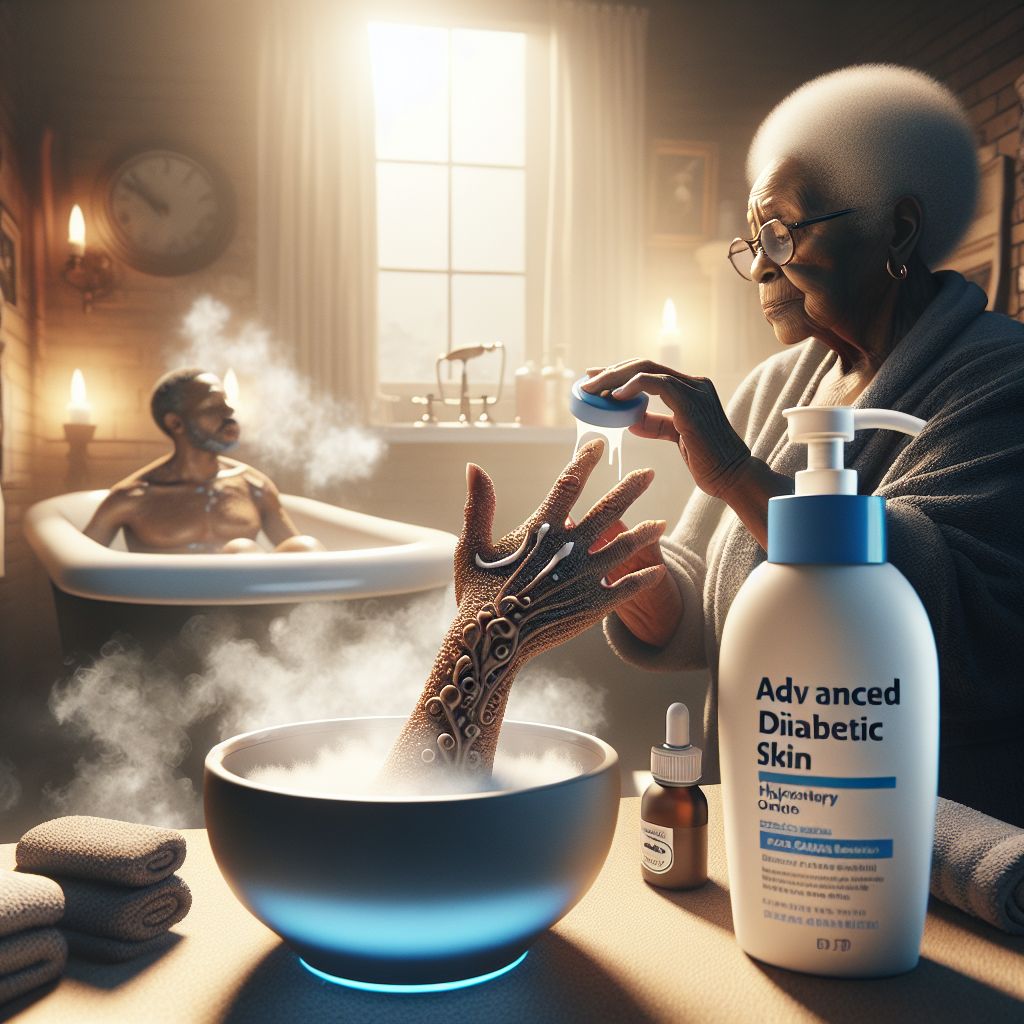
-
Diabetes can lead to dry, sensitive skin, making proper skincare essential.
-
Hydrotherapy offers therapeutic benefits for diabetic skin, but requires careful management post-treatment.
-
Humidifiers play a crucial role in maintaining skin hydration after hydrotherapy.
-
Choosing the right humidifier and maintaining it properly can prevent skin dryness.
-
Combining hydrotherapy with humidifier use can enhance skin health for diabetics.
Understanding Dry Skin and Diabetes
When you have diabetes, your skin can become a silent battleground. High blood sugar levels can cause nerve damage that affects your skin’s ability to retain moisture, leading to dryness and irritation. But it’s not just about discomfort; dry skin can crack, and those cracks can invite infections. This is why understanding and managing dry skin is not just a cosmetic concern for diabetics—it’s a health imperative.
Why Diabetic Skin Is Prone to Dryness
So, why does diabetes make skin more prone to dryness? For one, diabetes can affect blood flow, making it harder for your skin to stay moist and healthy. Additionally, high glucose levels can sap moisture from your skin, leaving it dry and prone to cracking. And let’s not forget that some medications used to manage diabetes can also dry out your skin. Therefore, keeping your skin hydrated is key to preventing complications.
Complications of Dry Skin for Diabetics
It’s not just about the itch or the flake; dry skin can lead to serious health issues for diabetics. Cracks in dry skin can become gateways for bacteria, leading to infections. These infections can be particularly dangerous for diabetics, as high sugar levels can feed bacteria, and compromised blood flow can slow healing. That’s why it’s crucial to keep your skin well-moisturized and to treat any cuts or cracks promptly.
Hydrotherapy as a Treatment Option

Hydrotherapy, which involves the use of water for pain relief and treatment, can be a godsend for diabetic skin. The soothing properties of water can help improve circulation and skin hydration. However, it’s not as simple as just taking a dip in the pool; there are specific guidelines you should follow to ensure that hydrotherapy is both safe and beneficial for your skin.
Benefits of Hydrotherapy for Diabetic Skin Care
Hydrotherapy can provide a multitude of benefits for diabetic skin. The warm water can enhance circulation, bringing nutrients and oxygen to skin cells. The hydration can help to plump up the skin, reducing the appearance of dryness and flakiness. But it’s important to remember that after you step out of the water, your skin is at risk of drying out even more if you don’t take the right steps to lock in that moisture.
Let’s break down the benefits of hydrotherapy for diabetic skin:
-
Enhances blood flow to the skin
-
Hydrates and soothes dry skin
-
Can help to gently exfoliate and improve skin texture
Guidelines for Safe Hydrotherapy Practices
To reap the benefits of hydrotherapy without risking further skin dryness or injury, follow these guidelines:
-
Keep the water temperature warm, not hot, to avoid skin irritation.
-
Limit your time in the water to prevent the skin from pruning and weakening.
-
After hydrotherapy, gently pat your skin dry instead of rubbing to avoid damage.
-
Immediately apply a moisturizer to lock in hydration.
Remember, the key is to keep the skin barrier intact while still enjoying the therapeutic effects of the water.
The Balancing Act: Humidifiers Post-Hydrotherapy

Now, here’s where humidifiers come into play. After hydrotherapy, when your skin is vulnerable and in need of extra care, a humidifier can help maintain the right level of humidity in your environment. This is crucial because, after soaking in water, your skin’s outer layer is full of moisture that can easily evaporate, especially in a dry environment.
Maintaining Skin Hydration After Hydrotherapy
Think of your post-hydrotherapy skin as a sponge full of water. If you leave it in a dry room, it will quickly dry out. A humidifier adds moisture to the air, which helps prevent the water in your skin from evaporating too quickly. This helps to keep your skin hydrated and can reduce the itchiness and flaking associated with dry skin.
Because maintaining the right level of humidity is crucial, especially after hydrotherapy, consider these points:
-
The ideal indoor humidity level for comfort and health is between 30% and 50%.
-
Use a hygrometer to measure the humidity in your home and adjust your humidifier accordingly.
-
During winter or in dry climates, using a humidifier can be particularly beneficial.
By managing the humidity in your environment, you’re taking a proactive step in caring for your diabetic skin.
Selecting the Right Humidifier for Diabetic Skin Care
Not all humidifiers are created equal, especially when it comes to diabetic skin care. You want a humidifier that’s easy to clean, to prevent mold and bacteria growth, and one that can maintain consistent humidity levels. Look for models with built-in hygrometers and automatic shut-off features to ensure optimal performance.
Consider these factors when choosing a humidifier:
-
Size and capacity appropriate for your space
-
Easy maintenance and cleaning
-
Quiet operation, especially for bedroom use
Remember, the right humidifier can make all the difference in keeping your skin healthy and hydrated.
Practical Tips for Using Humidifiers
Using a humidifier might seem straightforward, but there are some practical tips that can help you get the most out of this device, especially when managing diabetic skin. First, place your humidifier in a room where you spend a lot of time, like the bedroom or living room. This ensures that you’re benefiting from the increased humidity for the majority of the day or night. Additionally, be sure to use distilled or demineralized water in your humidifier to prevent mineral buildup and the release of these minerals into the air.
Humidifier Maintenance for Skin Health
Keeping your humidifier clean is non-negotiable. A dirty humidifier can breed mold and bacteria, which can be harmful when inhaled, especially for those with diabetes who may already have a compromised immune system. Clean your humidifier regularly, following the manufacturer’s instructions, and change the water daily. Also, replace filters or wicks as recommended to ensure your humidifier remains a friend, not a foe, to your skin.
Optimal Humidity Levels for Diabetic Skin
What’s the magic number for humidity levels? Aim for an indoor humidity level between 30% and 50%. This range helps to hydrate your skin without making your home so humid that it encourages the growth of mold and dust mites. Use a hygrometer to keep track of the humidity levels in your home and adjust your humidifier settings as needed to maintain these optimal conditions.
And remember, your skin’s needs may change with the seasons or even from day to day. Stay flexible and adjust your humidifier use accordingly.
Addressing Common Humidifier Concerns
Some people worry about the energy consumption of running a humidifier. Choose an energy-efficient model to alleviate this concern. Noise can also be an issue, particularly in bedrooms. Look for humidifiers advertised as “whisper-quiet” for a restful sleep. Lastly, there’s the question of white dust—a fine mist that can settle around the room, which is caused by minerals in the water. This can be avoided by using distilled water in your humidifier.
Alternative Dry Skin Management Strategies
Humidifiers are just one tool in your arsenal against dry diabetic skin. Moisturizing after bathing or showering can help lock in moisture. Opt for a thick, fragrance-free moisturizer to avoid skin irritation. Staying well-hydrated by drinking plenty of water is also crucial for maintaining skin health from the inside out.
Incorporating Moisturizers and Emollients
Moisturizers and emollients are essential in creating a protective layer on the skin, keeping it hydrated. For diabetic skin, it’s best to use products that are free from potential irritants like dyes and fragrances. Apply these products while the skin is still damp to seal in the moisture. Ointments and creams are generally more effective than lotions for treating dry skin.
Lifestyle Changes to Support Skin Health
Healthy lifestyle choices can have a significant impact on managing diabetic skin. Here’s what you can do:
-
Eat a balanced diet rich in omega-3 fatty acids to nourish the skin.
-
Engage in regular exercise to boost circulation to the skin.
-
Avoid smoking, which can impair circulation and exacerbate dry skin issues.
-
Meticulously manage your blood sugar levels to prevent skin complications.
These changes benefit not only your skin but also your overall diabetes management.
Expert Advice on Diabetic Skin Care
Proper skin care is essential for those with diabetes, and a comprehensive routine can greatly improve skin health. Gentle cleansing, consistent moisturizing, and vigilant monitoring for cuts or infections are key. Avoid harsh soaps and hot showers, which can strip the skin of its natural oils.
When to Consult a Healthcare Provider
If you notice persistent dryness, itching, or any signs of infection, it’s important to consult with a healthcare provider. Those with diabetes should be especially vigilant about skin care and seek medical advice promptly when skin issues arise.
Frequently Asked Questions (FAQ)
1. How Often Should I Use Hydrotherapy If I Have Diabetes?
Hydrotherapy can be used as part of a diabetic skin care routine, but it’s important to use it judiciously. Overuse can lead to over-hydration and exacerbate skin issues. Discuss with your healthcare provider to determine the right frequency for you, which may vary based on your individual skin condition and overall health.
2. Can Humidifiers Be Used Year-Round for Diabetic Skin Care?
Yes, humidifiers can be beneficial year-round, especially in dry climates or during winter months when indoor air tends to be drier. Adjust the humidity levels according to the season and your skin’s needs.
3. What Are the Signs of Over-Hydration in Diabetic Skin?
Over-hydration, or maceration, can occur when skin is exposed to moisture for too long. Signs include skin that looks soggy, feels overly soft, or is starting to break down, particularly between toes or in skin folds. If you notice these signs, reduce exposure to moisture and consult a healthcare provider.
4. Are There Any Risks to Using Humidifiers for Diabetics?
When used correctly, humidifiers pose minimal risk. However, if not maintained properly, they can harbor mold and bacteria, which can be harmful when inhaled. Always keep your humidifier clean and use distilled water to minimize risks.
5. What Other Precautions Should I Take When Managing Dry Diabetic Skin?
Besides using a humidifier, take precautions like avoiding extreme temperatures, using mild soaps, and wearing breathable fabrics. Always keep your skin moisturized, monitor your blood glucose levels, and maintain a healthy lifestyle to support skin health.



Leave a Reply